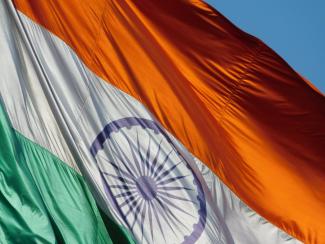
Anant Sharma courtesy of Unsplash.
India: The Emerging Global Power
2023 has been a momentous year for the world’s new most populous country, India. Aside from surpassing the population of China, India succeeded in its third-ever lunar mission and hosted the G20 summit in New Delhi. Beyond these achievements, the economy and stock market have been flying. This comes after the South Asian nation surpassed the UK to become the fifth-largest economy in the world (by GDP) in 2022. GDP is expected to have grown by around 6.5% for fiscal year 2023, following 7.2% growth in 2022. With a strong 2024, India will be within reach of catching Germany to become the fourth-largest economy in the world. This growth makes it the fastest-growing large economy. Also, within recent weeks, the National Stock Exchange of India has surpassed Hong Kong to become the seventh-largest equity market in the world, growing from $3.27 trillion of market capitalization in January to around $4.3 trillion today. India is well on its way to taking the next steps in becoming a global power.
While it is easy to be in awe of the past couple of years when it comes to India, the country has now set a trend of significant growth over many years. This trend can be identified by analyzing economic data, but it cannot be seen in many areas of the market. However, there is a particular area that has shined. Throughout the past decade, small-cap Indian stocks have performed exceptionally well. Between December 20, 2013, and December 20, 2023, the iShares MSCI India Small-Cap ETF (SMIN) gained 215.29%. To put this outstanding performance over the past decade into perspective, the SPDR S&P 500 ETF Trust (SPY) has gained 157.91% over the same period. The impressive returns alone show that India has been a viable country to invest in for many years if looking in the right spot. However, it must be mentioned that the volatility of SMIN has been relatively high and will likely continue to be. Other India ETFs have failed to replicate the returns of the small-cap fund, but many have held up throughout 2023. These include the WisdomTree India Earnings Fund (EPI), the Columbia India Consumer ETF (INCO), and the VanEck India Growth Leaders ETF (GLIN). There are various options for investors in the United States who are interested in investing in India.
While India and China are the two most populous countries in the world and are connected geographically, India should not be considered a replacement for China in an investment portfolio. Their vast cultural and political differences create different challenges and provide different benefits that could affect future growth prospects. On top of this, there are apparent discrepancies as far as development is concerned. This can be seen simply by looking at GDP, around $18 trillion for China versus $3.6 trillion for India. GDP per capita provides further context. For India, GDP per capita is around $2,500; for China, GDP per capita is $12,600. For perspective, the United States has a GDP per capita of around $80,000. This is just a tiny taste of what makes India different from China, but the takeaway should be that they are two different countries that face different issues, pose different risks for investors, and are not at the same point of development.
India has enjoyed a phenomenal year in 2023 and has the potential to build on its progress in 2024. However, although growth is expected to continue being strong, there are still many issues to solve in the world’s most populous nation. Notably, labor force participation is below 50%, whereas labor force participation is usually higher in developed countries. The problem of low labor force participation can often be challenging to solve as the solution often requires a change in culture as well as policy. Other issues include volatile unemployment rates and inflation. Both have generally improved over the past year, but India is prone to sudden spikes. India also lacks significant infrastructure and needs better education. As of 2021, only around 46% of the population used the internet (China: 76%, USA: 92%), far below what is necessary to become a healthy developed nation in our current world. Life expectancy is also poor at 67 years, according to the World Bank as of 2021. India’s life expectancy is below the world average of 71 and far below China’s (78) and the United States’ (76). Per capita income and poverty are other significant issues within India as well. As far as labor force participation and internet usage are concerned, there is a bright side. Even having come as far as it has over the past decade, India still has plenty of room for additional growth.
Investors may want to start paying more attention to India in the coming years, as the country is going through an exciting period. Regarding India as an investment, it is important to be aware of the risks due to both the potential for robust growth, as well as future challenges. India is not China and is not a one-for-one replacement in a portfolio, but it is about time we all start taking the South Asian powerhouse seriously.
Economic data from World Bank Open Data: https://data.worldbank.org/
ETF data from Yahoo Finance: https://finance.yahoo.com/

